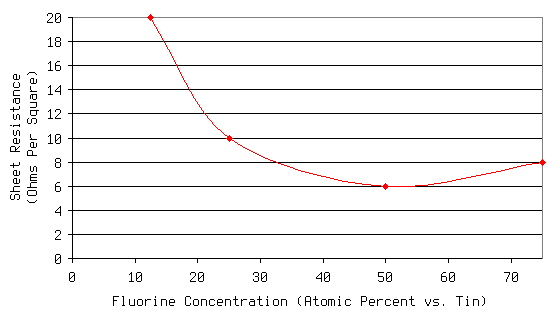
Experimenting with film thickness and fluorine concentration was fairly straightforward due to the consistency of the results. First, I kept the solution contents constant and varied the amount of solution to be sprayed, until the glass produced had a sheet resistance of approximately 10 ohms per square. For a 3 by 3 inch square of window glass this required 10mL of solution, but judging by the overspray on the hot plate, this amount could probably cover a 4 by 4 square just as easily. Next, I kept the solution volume constant at 10mL and varied the fluorine concentration, recording the best sheet resistance value for each concentration. A graph of that data can be seen below.

Following the graph, tin and fluorine should be in a 2:1 atomic ratio in the solution for optimal results. Using the same ingredients as in the previous article, this means the spray solution should contain the following:
I then used various volumes of the above solution to produce glass with different sheet resistances, which can be seen at the top of the page. The glass is highly transparent, with little to no discoloration or haze. The conductive film is mechanically durable and waterproof; it can be scrubbed clean with soap and water with no effect on the transparency or conductivity. Overall, this glass is comparable to commercial conductive glass, with one important difference: the cost. Commercial conductive glass, at the time of writing this article, costs approximately $1 per square inch. Discounting the cost of tools (since the tools required are common and may already be available), a square inch of the type of glass described here costs approximately 1¢ to produce. The importance of this development cannot be overstated. Over the past decade, I have seen many experimenters hit a wall while working on a project that requires a transparent conductor, due to the high cost of commercial products and the inadequacy of homemade solutions. I believe this is now a solved problem. I have included a video below, which demonstrates the simplicity of the deposition process. Anyone can do this.
Since I first wrote this article I have made multiple square feet of this glass, and have discovered a number of additional details regarding the process: